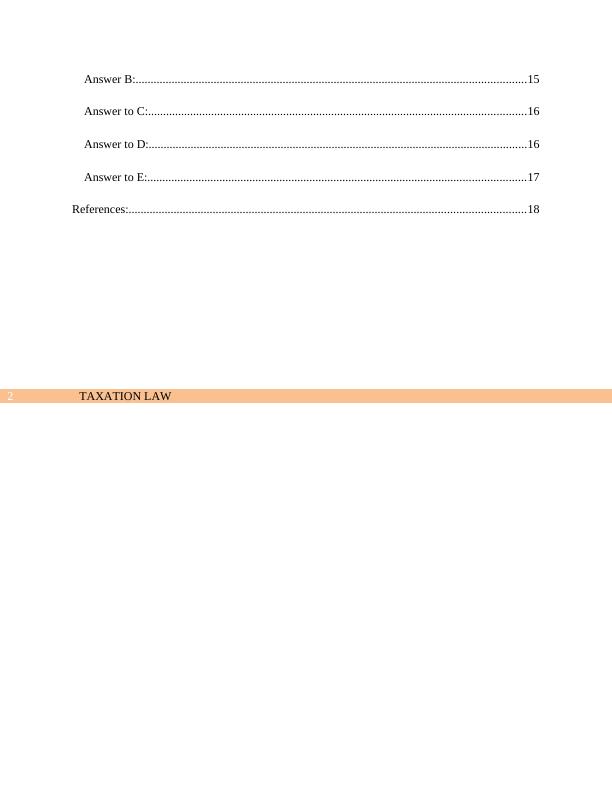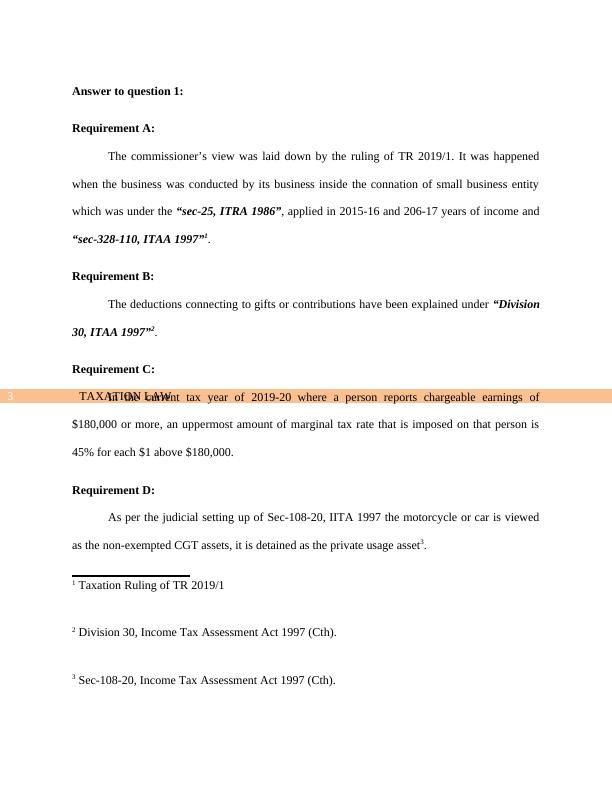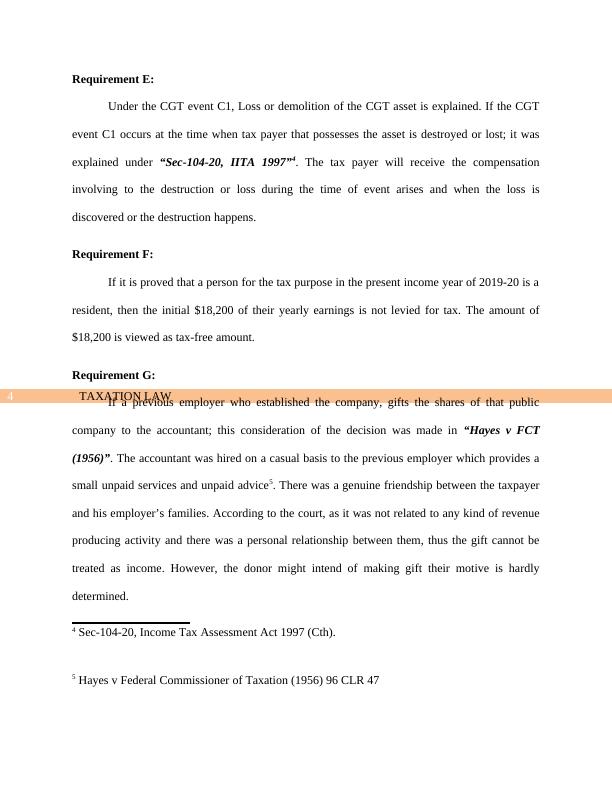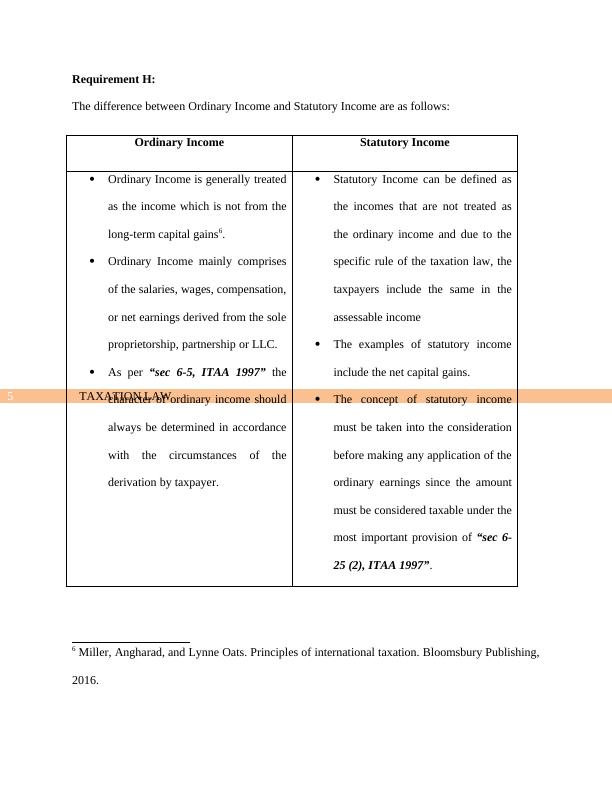Taxation Law
Added on 2022-12-28
21 Pages4006 Words65 Views
Running head: TAXATION LAW
Taxation Law
Name of the Student
Name of the University
Authors Note
Couse ID
Taxation Law
Name of the Student
Name of the University
Authors Note
Couse ID

TAXATION LAW1
Table of Contents
Answer to question 1:......................................................................................................................3
Requirement A:............................................................................................................................3
Requirement B:............................................................................................................................3
Requirement C:............................................................................................................................3
Requirement D:............................................................................................................................3
Requirement E:............................................................................................................................4
Requirement F:............................................................................................................................4
Requirement G:............................................................................................................................4
Requirement H:............................................................................................................................5
Requirement I:.............................................................................................................................6
Answer to question 2:......................................................................................................................6
Answer to question 3:......................................................................................................................8
Answer to question 4:....................................................................................................................12
Answer to A:..............................................................................................................................12
Answer to B:..............................................................................................................................12
Answer to C:..............................................................................................................................13
Answer to D:..............................................................................................................................14
Answer to question 5:....................................................................................................................15
Answer A:..................................................................................................................................15
Table of Contents
Answer to question 1:......................................................................................................................3
Requirement A:............................................................................................................................3
Requirement B:............................................................................................................................3
Requirement C:............................................................................................................................3
Requirement D:............................................................................................................................3
Requirement E:............................................................................................................................4
Requirement F:............................................................................................................................4
Requirement G:............................................................................................................................4
Requirement H:............................................................................................................................5
Requirement I:.............................................................................................................................6
Answer to question 2:......................................................................................................................6
Answer to question 3:......................................................................................................................8
Answer to question 4:....................................................................................................................12
Answer to A:..............................................................................................................................12
Answer to B:..............................................................................................................................12
Answer to C:..............................................................................................................................13
Answer to D:..............................................................................................................................14
Answer to question 5:....................................................................................................................15
Answer A:..................................................................................................................................15

TAXATION LAW2
Answer B:..................................................................................................................................15
Answer to C:..............................................................................................................................16
Answer to D:..............................................................................................................................16
Answer to E:..............................................................................................................................17
References:....................................................................................................................................18
Answer B:..................................................................................................................................15
Answer to C:..............................................................................................................................16
Answer to D:..............................................................................................................................16
Answer to E:..............................................................................................................................17
References:....................................................................................................................................18

TAXATION LAW3
Answer to question 1:
Requirement A:
The commissioner’s view was laid down by the ruling of TR 2019/1. It was happened
when the business was conducted by its business inside the connation of small business entity
which was under the “sec-25, ITRA 1986”, applied in 2015-16 and 206-17 years of income and
“sec-328-110, ITAA 1997”1.
Requirement B:
The deductions connecting to gifts or contributions have been explained under “Division
30, ITAA 1997”2.
Requirement C:
In the current tax year of 2019-20 where a person reports chargeable earnings of
$180,000 or more, an uppermost amount of marginal tax rate that is imposed on that person is
45% for each $1 above $180,000.
Requirement D:
As per the judicial setting up of Sec-108-20, IITA 1997 the motorcycle or car is viewed
as the non-exempted CGT assets, it is detained as the private usage asset3.
1 Taxation Ruling of TR 2019/1
2 Division 30, Income Tax Assessment Act 1997 (Cth).
3 Sec-108-20, Income Tax Assessment Act 1997 (Cth).
Answer to question 1:
Requirement A:
The commissioner’s view was laid down by the ruling of TR 2019/1. It was happened
when the business was conducted by its business inside the connation of small business entity
which was under the “sec-25, ITRA 1986”, applied in 2015-16 and 206-17 years of income and
“sec-328-110, ITAA 1997”1.
Requirement B:
The deductions connecting to gifts or contributions have been explained under “Division
30, ITAA 1997”2.
Requirement C:
In the current tax year of 2019-20 where a person reports chargeable earnings of
$180,000 or more, an uppermost amount of marginal tax rate that is imposed on that person is
45% for each $1 above $180,000.
Requirement D:
As per the judicial setting up of Sec-108-20, IITA 1997 the motorcycle or car is viewed
as the non-exempted CGT assets, it is detained as the private usage asset3.
1 Taxation Ruling of TR 2019/1
2 Division 30, Income Tax Assessment Act 1997 (Cth).
3 Sec-108-20, Income Tax Assessment Act 1997 (Cth).

TAXATION LAW4
Requirement E:
Under the CGT event C1, Loss or demolition of the CGT asset is explained. If the CGT
event C1 occurs at the time when tax payer that possesses the asset is destroyed or lost; it was
explained under “Sec-104-20, IITA 1997”4. The tax payer will receive the compensation
involving to the destruction or loss during the time of event arises and when the loss is
discovered or the destruction happens.
Requirement F:
If it is proved that a person for the tax purpose in the present income year of 2019-20 is a
resident, then the initial $18,200 of their yearly earnings is not levied for tax. The amount of
$18,200 is viewed as tax-free amount.
Requirement G:
If a previous employer who established the company, gifts the shares of that public
company to the accountant; this consideration of the decision was made in “Hayes v FCT
(1956)”. The accountant was hired on a casual basis to the previous employer which provides a
small unpaid services and unpaid advice5. There was a genuine friendship between the taxpayer
and his employer’s families. According to the court, as it was not related to any kind of revenue
producing activity and there was a personal relationship between them, thus the gift cannot be
treated as income. However, the donor might intend of making gift their motive is hardly
determined.
4 Sec-104-20, Income Tax Assessment Act 1997 (Cth).
5 Hayes v Federal Commissioner of Taxation (1956) 96 CLR 47
Requirement E:
Under the CGT event C1, Loss or demolition of the CGT asset is explained. If the CGT
event C1 occurs at the time when tax payer that possesses the asset is destroyed or lost; it was
explained under “Sec-104-20, IITA 1997”4. The tax payer will receive the compensation
involving to the destruction or loss during the time of event arises and when the loss is
discovered or the destruction happens.
Requirement F:
If it is proved that a person for the tax purpose in the present income year of 2019-20 is a
resident, then the initial $18,200 of their yearly earnings is not levied for tax. The amount of
$18,200 is viewed as tax-free amount.
Requirement G:
If a previous employer who established the company, gifts the shares of that public
company to the accountant; this consideration of the decision was made in “Hayes v FCT
(1956)”. The accountant was hired on a casual basis to the previous employer which provides a
small unpaid services and unpaid advice5. There was a genuine friendship between the taxpayer
and his employer’s families. According to the court, as it was not related to any kind of revenue
producing activity and there was a personal relationship between them, thus the gift cannot be
treated as income. However, the donor might intend of making gift their motive is hardly
determined.
4 Sec-104-20, Income Tax Assessment Act 1997 (Cth).
5 Hayes v Federal Commissioner of Taxation (1956) 96 CLR 47

TAXATION LAW5
Requirement H:
The difference between Ordinary Income and Statutory Income are as follows:
Ordinary Income Statutory Income
Ordinary Income is generally treated
as the income which is not from the
long-term capital gains6.
Ordinary Income mainly comprises
of the salaries, wages, compensation,
or net earnings derived from the sole
proprietorship, partnership or LLC.
As per “sec 6-5, ITAA 1997” the
character of ordinary income should
always be determined in accordance
with the circumstances of the
derivation by taxpayer.
Statutory Income can be defined as
the incomes that are not treated as
the ordinary income and due to the
specific rule of the taxation law, the
taxpayers include the same in the
assessable income
The examples of statutory income
include the net capital gains.
The concept of statutory income
must be taken into the consideration
before making any application of the
ordinary earnings since the amount
must be considered taxable under the
most important provision of “sec 6-
25 (2), ITAA 1997”.
6 Miller, Angharad, and Lynne Oats. Principles of international taxation. Bloomsbury Publishing,
2016.
Requirement H:
The difference between Ordinary Income and Statutory Income are as follows:
Ordinary Income Statutory Income
Ordinary Income is generally treated
as the income which is not from the
long-term capital gains6.
Ordinary Income mainly comprises
of the salaries, wages, compensation,
or net earnings derived from the sole
proprietorship, partnership or LLC.
As per “sec 6-5, ITAA 1997” the
character of ordinary income should
always be determined in accordance
with the circumstances of the
derivation by taxpayer.
Statutory Income can be defined as
the incomes that are not treated as
the ordinary income and due to the
specific rule of the taxation law, the
taxpayers include the same in the
assessable income
The examples of statutory income
include the net capital gains.
The concept of statutory income
must be taken into the consideration
before making any application of the
ordinary earnings since the amount
must be considered taxable under the
most important provision of “sec 6-
25 (2), ITAA 1997”.
6 Miller, Angharad, and Lynne Oats. Principles of international taxation. Bloomsbury Publishing,
2016.

End of preview
Want to access all the pages? Upload your documents or become a member.
Related Documents
Course of Taxation Law 2022lg...
|19
|3678
|21
Taxation Lawlg...
|20
|4079
|96
Answer to question 1: Taxation Law Name of the University Authors' Namelg...
|17
|3562
|242
Taxation Lawlg...
|18
|3675
|50
Taxation Lawlg...
|20
|4118
|77
Taxaxtion Law Question Answer 2022lg...
|19
|3519
|12